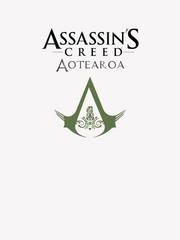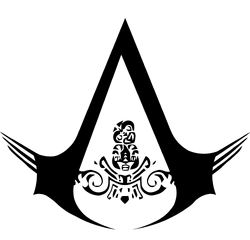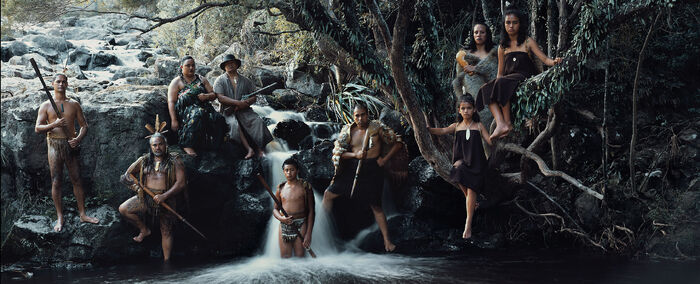
Assassin's Creed Aotearoa
| New Zealand Brotherhood | |
|---|---|
 | |
| Organizational information | |
| Founder |
Catherine Hagerty |
| Leader's title | |
| Headquarters | |
| Locations | |
| Related organizations | |
| Religion | |
| Historical information | |
| Date formed |
1806 |
| Date reorganized |
1872 |
| Additional information | |
| Notable members | |
The New Zealand Brotherhood of Assassins, originally the Aoteaharakore, is the branch of the Assassin Brotherhood that operates in and around New Zealand. Founded in 1806 by Charlotte Badger, John O'Reilly and Catherine Hagerty, all former pirates and criminals, they escaped to uncharted lands in search of freedom and liberty.
This Assassin Brotherhood branch is unique and unconventional when compared to other, more organized orders of the creed, as they were established through non-traditional means, built upon through appropriation and misinterpretation. The founder members, though Assassin affiliates, had no true knowledge of how the creed was originally operated and had invented their own concepts as they lived. Fortunately, in 1872, the branch was reorganized by emissaries of the British Brotherhood, instilling traditional Assassin ideals, intentions, and practices within the New Zealand branch while preserving their original conceptions.
Over the course of 200 years, the guild has been influential in a variety of phases in the history of New Zealand. Opposing colonial Templar rule and occupation, the New Zealand Brotherhood has been associated with numerous key events, from encouraging foreigner-Maori relations and immigration, to the signing of the Treaty of Waitangi in 1840, vigorous participation in the 30 year Land Wars, and ultimately, empowering the country to attain full independence from Britain in 1947.
History
Formation (1801 – 1806)
An exceptional mutiny of a wayward crew, a couple of damsels, a cunning first mate, and a company of convicted criminals would ultimately form the foundation of the modern-day New Zealand Brotherhood bred from a unique and unlikely origin. On April 22nd, 1806, the Colonial brigantine named 'Venus', which was owned by Templar Robert Campbell and under the command of the Templar-affiliated Captain, Samuel Chase, rested at anchor at Twofold Bay, Port Dalrymple, on the northern coast of Tasmania, Australia. Aboard she had a consignment of grains, seeds, flour and seasoned meats bound for the settlement of Hobart, the capital of the Tasmania state.
On June 17th, 1806, while moored at the Dalrymple Port on the northern coasts of Tasmania, the passengers and convicts mutinied and forcibly seized control of the Venus with the aid of the first mate, Benjamin Kelly and the leadership of Charlotte Badger, who was said to have sparked the insurrection. They had fortified themselves with muskets, flintlocks and a plethora of ammunition and seized command of the ship, supported and assisted by the two lady criminals. The second mate, Richard Edwards who was a Templar agent, stubbornly resisted but was overwhelmed, lashed by the women, beaten unconscious, and thrown below deck where he was imprisoned in the same cell the convicts once shared.
Five members of the loyal crew refused to participate in the mutiny and were put ashore and left to break the news to Captain Chase. He returned to find the vessel underway with Richard Thompson at the helm, setting a course for New Zealand and the Bay of Islands.
(TBD)
After successfully assimilating with the local Maori people of Rangihoua, they became known as the Aoteaharakore, which can be loosely transliterated into English as the 'Lawless New Worlders': 'Aotea' can be interpreted as 'World', 'Hara' would mean to offend or go against law, and 'kore' would translate into 'less' or 'without' and is used after nouns to indicate absence.
Te Kooti's War (1868 – 1872)
Te Kooti's War was among the last of the New Zealand wars, the series of 19th-century conflicts between the Māori and the colonizing European settlers.
Māori King Movement (1858 – present)
Te Mana Kingitanga, revised by historians as the Māori King Movement, was an antagonistic movement that arose through the New Zealand Brotherhood's arbitration and local Māori tribes in the central North Island in 1858, with the goal of securing a role similar in status to that of Queen Victoria of the British imperialist-colonists, as a way of preventing the alienation and annexation of Māori land and monuments.
Present Day
As of the year 2018 AD, the New Zealand Brotherhood, abbreviated and referred to as the NZB, is comparatively intact and active though largely independent from other Assassin Brotherhood cells hidden throughout the world in modern times. The unique isolation and extreme global distance would prove to be beneficial in the year 2000, which protected the New Zealand Brotherhood during the Great Purge and subsequent raids by Abstergo agents. As they were left relatively unscathed with only small pockets found and eliminated within the country, they have been able to survive and endure and have even fostered evacuees from surviving branches until they were ready to redeploy in the field. The Brotherhood has forty-seven active Assassins at present, and ordinarily, have ten of them on-call while the rest are working in the field or operating on-site at their headquarters, Rangi.
Bureaus
Past
Kororāreka
Paihia
Parihaka
Pukehinahina
Rangihoua Bay
Present
Rangi (HQ)
Bastion Point
Russel
Ihumatao
Appearance
(1800s – 1860s)
Initial members of the group were generally split between two diverse ethnic groups: foreigner fugitives generally of European descent known as 'Pakeha', and native Maori tribals of Te Ika-a-Māui. Both societies had drastically different attires though they would eventually mix and merge the two cultures into one.
(1980s – 2010s)
In the modern age and throughout the turn of the millennia, initiates and members have been advised (and cautioned) to wear discreet and sensible urban clothing while in public, which is usually attire of a dull colored off brand with minimal symbols to stay inconspicuous. The hoodie is a general item worn by members, though it is not a mandatory uniform, as the Brotherhood relies heavily on secrecy to survive and the best way to do that is to blend in by adopting everyday civilian clothing, tastes, and fashions. With this modest and inconspicuous approach to their appearance, the Brotherhood has been able to stay relatively invisible and off the radar for decades, while still being steadily active in plain sight and society.
It is not uncommon, however, for members to wear identifiable items which show that they are affiliated with the Brotherhood, although many choose to not wear any distinguishable pieces at all, in fear of being discovered by enemy cells while in the field. These items can be treasures handed down since ancient times by ancestors, family heirlooms or tribal affiliations, or simply items which bring pride to the wearer. Despite the heightened risk accompanied by wearing or carrying such items, it does bring a sense of superficial pride or "Mana", to the bearer of the piece or item.
Identifiable items or features of a New Zealand Assassin, though usually hidden from the public eye, may include but are not limited to: eccentrically carved tribal tattoos covering large swathes of the skin, though of which are customarily concealed beneath clothing and end at the forearms and neck; Native bird feathers or seashell derivatives, which can be either worn as accessories or woven into apparel. and most prominently, carved "Pounamu" necklaces known as "Hei-tiki", which is a representative symbol of the first man created in Maori mythology and of the proto-Assassin ancestor, Tiki, also known as Adam. Pounamu necklaces, bracelets, earrings and other accessories can come in different symbolic shapes with various meanings, though the Hei-tiki is the most traditional and has also been incorporated into the Assassin insignia.
Members
18th Century
Charlotte Badger (1778 - 1844)
19th Century
Hone Heke (1807 - 1850)
Te Kooti (1832 - 1891)
20th Century
21th Century
Hami Badger

